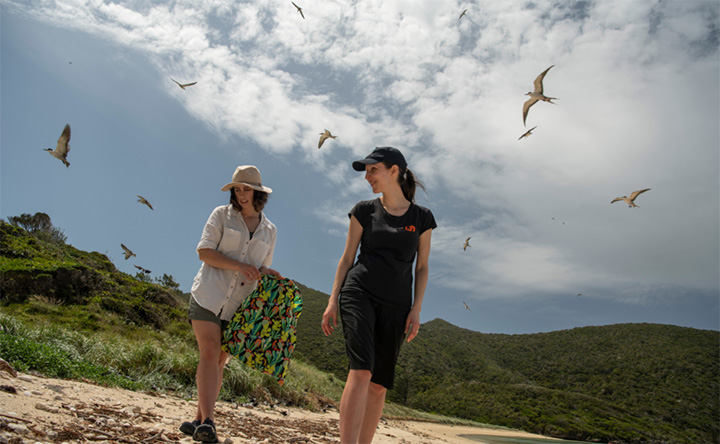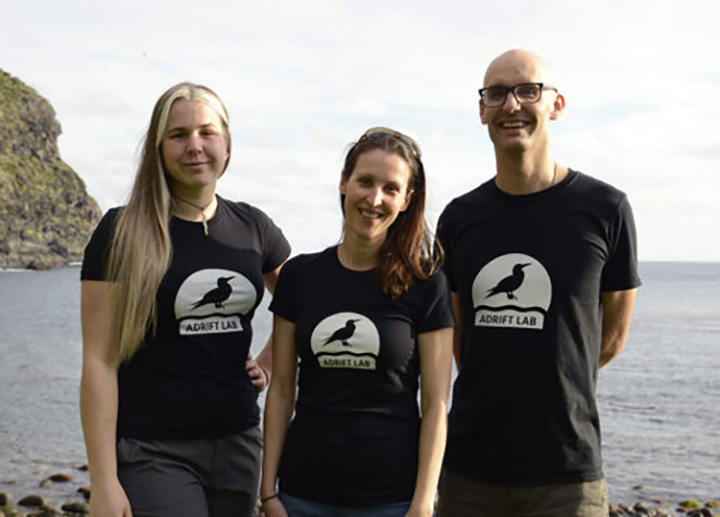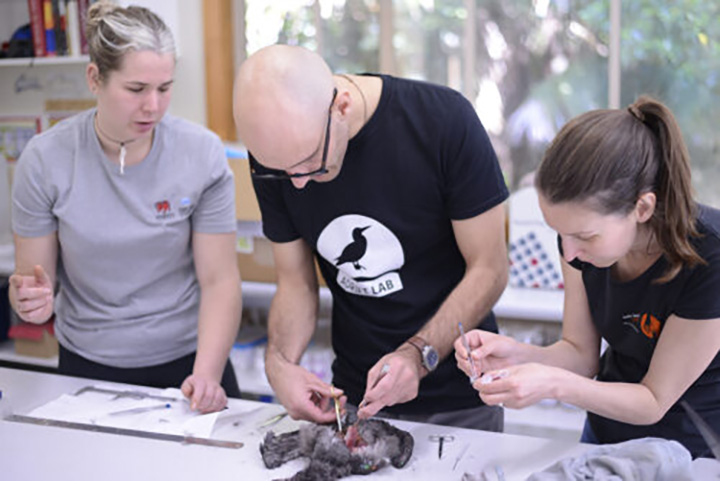Plastics, a global problem
November 5, 2021

Photo credit: Justin Gilligan
Doctor Jennifer Lavers, originally from Edmonton in Canada, now lives on the other side of the world in Tasmania, conducting research on remote islands.
The Lecturer in Marine Science at the Institute of Marine and Antarctic studies at the University of Tasmania, has witnessed firsthand the catastrophic impacts of plastic pollution on the world’s wildlife.
It was in Newfoundland and Labrador, in the north of Canada, that Dr Lavers found her passion for seabirds. Having studied at the University of Alberta, Dr Lavers said that she didn’t have much expertise in the ocean – it was after all over 1000 kilometres away.
“I knew very little – remarkably little actually – about the ocean,” she said. “It’s ironic that I am now a marine biologist, and the ocean is my area of expertise.”
At the age of 25, while studying her PhD at Memorial University in Newfoundland, she discovered the incredible world of seabirds.
“It was a remarkable place, and it was a life changing pivotal moment,” she said. “I ended up getting sent by wooden tall ship up to north-central Labrador to some more remote, uninhabited far-flung islands, which are infested with beautiful seabirds. It threw me so far out of my comfort zone and into a place where I felt like I belonged and there was just no turning back from me. From there, I was completely hooked on seabirds and islands.”
She said that while her research was focussed on seabird ecology, not the impacts of human-caused climate change, she began to uncover first-hand that the two were intrinsically linked.

Photo credit: Silke Stuckenbrock
“My PhD thesis was not originally meant to be on anthropogenic pressures, but it ultimately ended up including some of those,” Dr Lavers said.
Through conversations with indigenous elders and reading scientific papers from a couple of decades ago, she could see that human action had impacted the landscape significantly.
“The message was very clear,” she said.
Ship traffic had access to areas previously not accessible, as the ice had retracted. Even in the colder months, ice bridges that had provided safe passage for people for centuries were now unreliable.
“I was only 25 years at that point, so it was literally in my lifetime that all this had all but vanished in a short window.”
Dr Lavers said that her time in the sub-arctic of Canada got her hooked on researching uninhabited islands. She said from there, she “island hopped” all the way to Tasmania – from the sub-arctic to remote islands of Hawaii and eventually finding herself at the island off the south of Australia.
“I remember landing here on the 27th of May 2007 and thinking this place is amazing and I might just have to stay here for a little while,” she said. “Here we are 15 years later.”
Dr Lavers is part of the Adrift Lab at the University of Tasmania, which conducts marine plastic and seabird research. The Adrift Lab scientists closely monitors specific species seabirds to be able to gain insight into the health of the wider ecosystem.
“If our seabird populations are doing well, then everything below them in the marine food web must also be doing quite well,” Dr Lavers explains.
By collecting data on the health of seabirds, including the amount of plastic that they are ingesting, scientists are able to monitor for changes and trends over time, which means that they can also monitor whether policy changes are having impacts on our wildlife.
Her time in sub-arctic Canada revealed to her the impacts of climate change, and now on the other side of the world, she is confronted daily by another human-made environmental pressure: plastic pollution. Working on remote, often uninhabited islands in the southern hemisphere, Dr Lavers and her team at the Adrift Lab record the devastating impacts of plastic on seabirds.
“There’s a lot of things I do in my everyday job that are really awful things,” she said.
She said that she regularly has to euthanize wild animals that are suffering, often from having ingested plastics. She conducts necropsy of already deceased animals, which involves removing hundreds of pieces of ingested plastics. Her team physically flush plastic from seabird’s stomachs in order to give them a chance to survive.
She said that to get through the work, she needs to shut off and carry out her research like a robot, but that once she has returned from the field, she’s hit full force with the weight of what she has seen.
“I come home and I shake,” she said.
She said it is important that the scientific community have discussions about what it is like to experience trauma while conducting research. She said that for a long time, many scientists felt they could not discuss their feelings and conduct objective research at the same time.
Dr Lavers disagrees.
“Scientists are human, so we can be objective by design of what we do as scientists, but we can also fall apart when we need to and pick ourselves back up just like the rest of the world does,” she said.
Despite facing such confronting challenges, Dr Lavers is committed to continuing her research and supporting her students to carry on the work.

Photo credit: Paul Sharp
“I do not wave the white flag,” she said. “That’s what I teach my students, and what I live by.”
For her, part of refusing to surrender to this environmental disaster, is “rallying the troops”, which means getting people outside of the scientific community to understand the plastic pollution crisis.
She said her approach to getting people on board has changed over time. Around 10 years ago, she posted a video on YouTube of herself extracting 276 pieces of plastic from a 90-day-old seabird chick.
“We thought we were going to rally the troops with that one,” she said.
However, she said the response from people surprised her. While about half the people who saw the video felt mobilised to combat plastic pollution, the other half switched off.
“There was the other 50% that said, ‘No, I don’t want to hear about it, it’s too much, turn it off’,” Dr Lavers said. “This was not my goal.”
She said that was a pivotal moment for her, where she realised that she would need to be more sensitive and inclusive to get people on board.
“We need to be mindful about how different people engage with issues and we can’t have an all or nothing approach,” she said.
This is what has led Dr Lavers and the Adrift Lab to partner with artists to showcase their work to the public. Dr Lavers said that scientific papers are filled with jargon, are “incredibly dull” and often behind a paywall. When research is presented, it is usually at a scientific conference – again, not accessible to the public.
“All of this is about preaching to the converted,” Dr Lavers said. “I really rebel against that – if we want to rally the troops, that’s not how to do it.”
She said that working with photographers, writers, poets and other creatives, is a way to present the message to new groups of people.
In 2019 the Adrift Lab partnered with international award-winning photographer Mandy Barker, to capture the marine plastic debris plaguing Henderson Island.
A UNESCO world heritage site over 5000 kilometres from the nearest landmass, Henderson Island is completely uninhabited, but has one of the most densely plastic polluted beaches on the planet. Despite humans never having lived on the island, our collective impact on the small land mass is vast.
In a striking photo series, Barker showed how the world’s waste has inundated this remote island. The images of the recovered plastic also identify the country where the plastic originally came from, with 25 different countries identified.
Dr Lavers said that this demonstrates how plastic pollution is a global problem.
“It’s coming from everywhere. One countries waste becomes the other countries problem,” she said. “We all have a role to play in this.”
By using art as a medium to expose the situation on remote islands, the Adrift Lab have reached international audiences, and have been featured at the London and Sydney Design Biennales. The Adrift Lab is currently working with renowned photographer Justin Gilligan, who is also a resident of Lord Howe Island, where Dr Lavers and the team are completing field work. Dr Lavers said that working with and bringing along local communities, is essential to the work that she is carrying out.
With their scientific research entering realms completely outside of the usual science conferences, Dr Lavers is continuing to get more people on board with combating plastic pollution. If she could get people to do one thing for the cause, it would be for people to start having conversations with the people who are not on board.
“It falls on the rest of us to have those conversations with those difficult few, because we need them,” she said.
She said meaningful change will only happen when everyone is taking part in that change.
“Be ready to have tough conversations – don’t preach to the converted.”
She said that there are so many ways to help people understand the plastic crisis, and there’s no single way for people to gain that knowledge. While scientific papers may be the medium for some people to learn, art could be the better and more interesting mode for others.
“The keep cups, and bamboo toothbrushes and the cotton reusable bags and all that kind of stuff that will come with the knowing,” she said. “We need all of us involved in these crises, involved in talking about it and finding solutions, lobbying politicians.”
- Date modified: